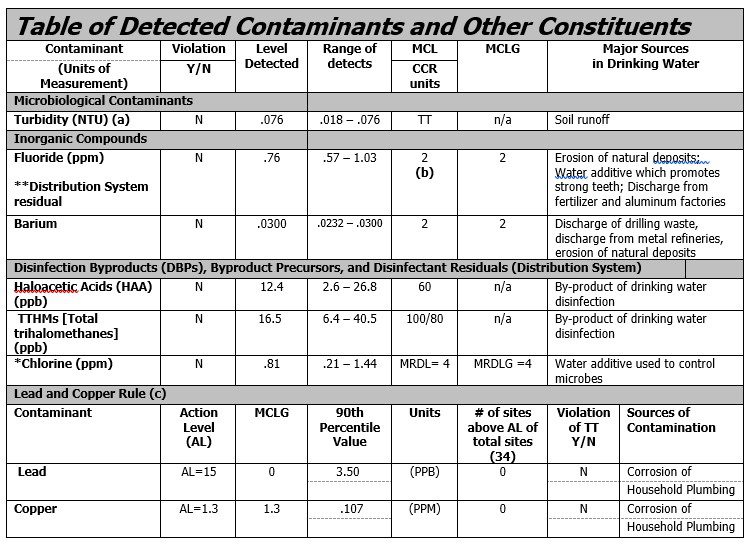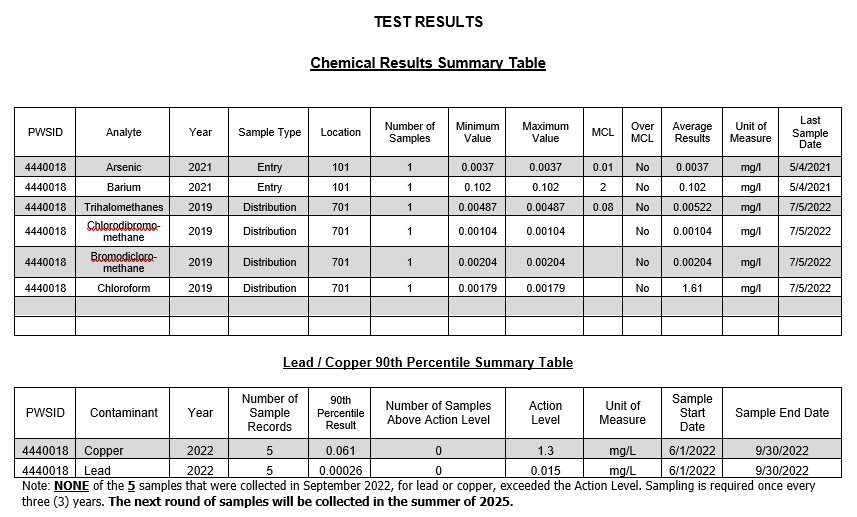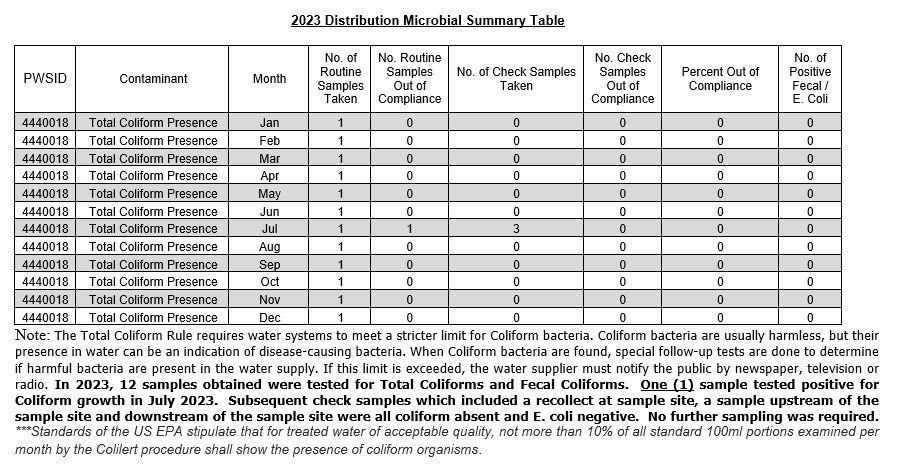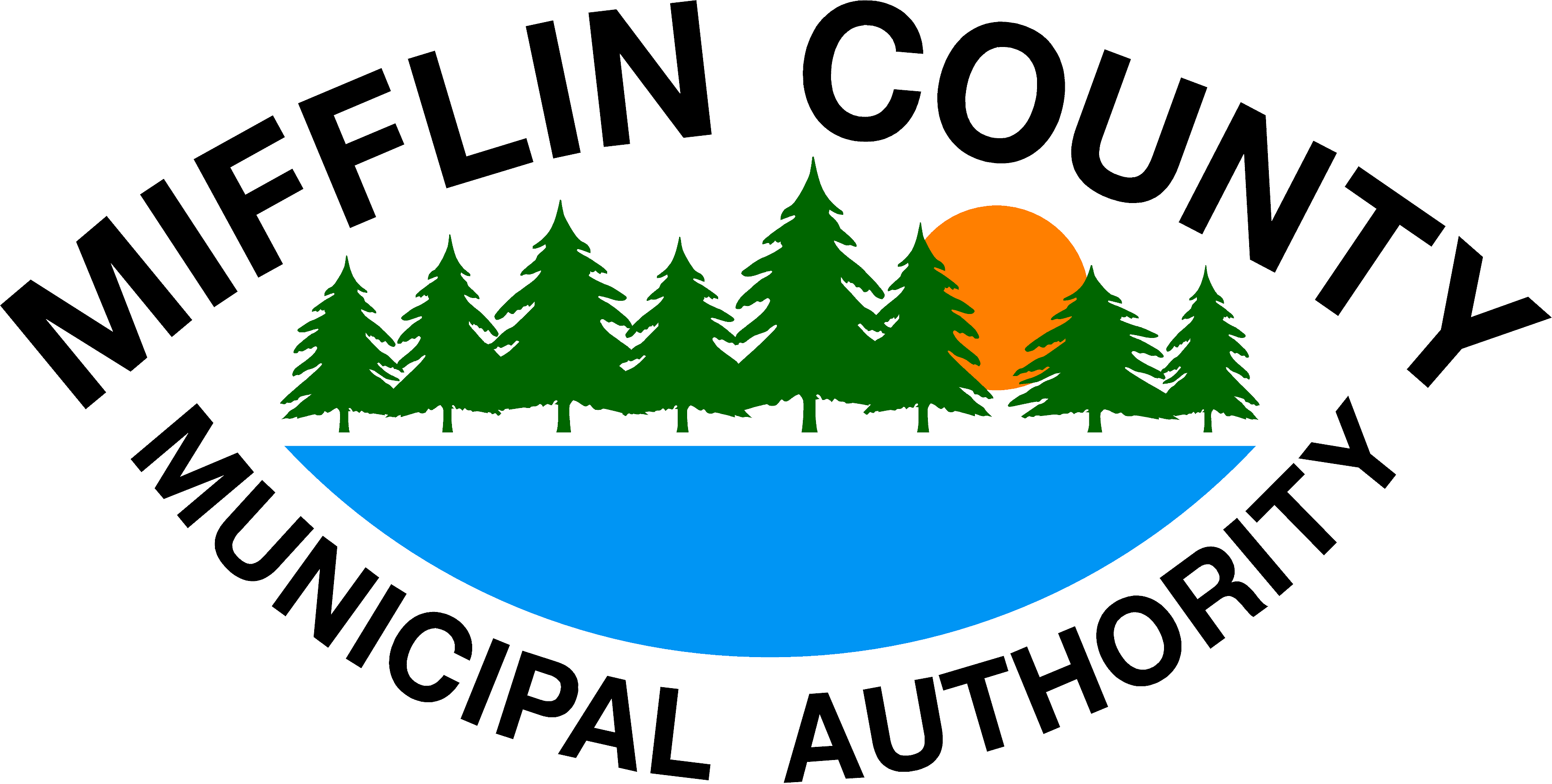Annual Drinking Water Quality Report
2023
Mifflin County Municipal Authority
PWSID# 4440010
Este informe contiene informacion muy importante sobre su agua de beber.Traduzcalo o hable con alguien que lo entienda bien.
(This report contains very important information about your drinking water. Translate it, or speak to someone who understands it.)
The Mifflin County Municipal Authority (MCMA) is pleased to present to you this year's Annual Drinking Water Quality Report. This report is designed to inform you about water quality and the services MCMA delivers to you every day. Our constant goal is to provide you with a dependable supply of drinking water. MCMA wants you to understand the efforts made to continually improve the water treatment process and protect our water resources. MCMA is committed to ensuring the quality of your water. The primary water source is the Laurel Creek Reservoir. In addition to that source, MCMA is permitted to draw from three groundwater sources (wells), throughout the service area. Those wells were utilized for limited production in 2023. In 2023, over 1.01 BILLION GALLONS of drinking water was produced for over 11,000 customers. That’s nearly 2.76 million gallons per day!
In 2023, MCMA received a prestigious award. In October, MCMA was awarded the Partnership for Safe Drinking Water Program’s Treatment Plant Optimization award. MCMA was recognized for efforts to produce high quality drinking water that exceeds regulatory requirements. This was the 16th consecutive year that MCMA has been given this award! MCMA is one of only sixteen treatment plants statewide to achieve this honor.
Also, in 2024, The PA Department of Environmental Protection (DEP) performed its triennial Filter Plant Performance Evaluation (FPPE) on March 11-12, 2024. As a result of that extensive evaluation, MCMA garnered the highest level of achievement, a Commendable rating!
A source water assessment report is available at the MCMA office. The report provides detailed information for potential sources of contamination. A summary of our water system’s susceptibility to potential sources of contamination follows:
In 2024, Mifflin County Municipal Authority developed a comprehensive Source Water Protection Plan to protect their water sources. This project delineated protection areas for the water sources, identified potential sources of contamination, planned for potential pollution events, and selected management strategies that can be implemented in the future. This assessment found that our sources are potentially most susceptible to transportation corridors and cleanup sites. Public education and watershed improvements are the primary focus of the program, which will benefit all residents and companies working and living in our service area. More information is available by contacting MCMA at 717-248-0165.
If you have any questions about this report or concerning your water utility, please contact Craig A. Bubb, Executive Director, at 717-248-0165. We want our valued customers to be informed about their water utility. If you want to learn more, please attend any of the regularly scheduled meetings. Meetings are held on the third Wednesday of every month at 1:00pm at the Derry Township Municipal Office, 73 Reserve Lane, Lewistown.
MCMA routinely monitors for contaminants in your drinking water according to Federal and State laws. This table shows the results of our monitoring for the period of January 1st to December 31st, 2023. All drinking water, including bottled drinking water, may be reasonably expected to contain at least small amounts of some constituents. It's important to remember that the presence of these constituents does not necessarily pose a health risk.
Some people may be more vulnerable to contaminants in drinking water than the general population. Immuno-compromised persons such as persons with cancer undergoing chemotherapy, persons who have undergone organ transplants, people with HIV/AIDS or other immune system disorders, some elderly, and infants can be particularly at risk from infections. These people should seek advice about drinking water from their health care providers. EPA/CDC guidelines on appropriate means to lessen the risk of infection by cryptosporidium and other microbiological contaminants are available from the Safe Drinking Water Hotline (800-426-4791).
All sources of drinking water are subject to potential contaminants that are naturally occurring or man made. Those contaminants can be microbes, organic or inorganic chemicals, or radioactive materials. Drinking water, including bottled water, may reasonably be expected to contain at least small amounts of some contaminants. The presence of contaminants does not necessarily indicate that the water poses a health risk. More information about contaminants and potential health effects can be obtained by calling the Environmental Protection Agency’s Safe Drinking Water Hotline at 1-800-426-4791.
Table of Detected Contaminants and Other Constituents

Footnotes to the preceding table:
(a) Turbidity is a measure of the cloudiness of the water. Turbidity levels are continuously monitored because it is a good indicator of the effectiveness of our filtration system.
On November 15th, the MAXIMUM combined filtered turbidity value (.076 NTU) was recorded. In November 100% of turbidity samples met the turbidity limits set by the PA DEP. The range of detects in this table reflect the highest levels recorded in 2023. Our filtered water must remain below .3 NTU to be in compliance with the PA DEP. MCMA has voluntarily set a limit of .1 NTU, (3 times LESS than required), through our membership with The Partnership for Safe Drinking Water, a national association for water suppliers, administered and monitored by the US EPA.
(b) US EPA’s MCL for Fluoride is 4 ppm. PA has set a lower limit for Fluoride at 2 ppm. These results were obtained during our routine monitoring in the Distribution System.
(c) NONE of the 34 samples that were collected in June 2022, for lead or copper, exceeded the Action Level. Sampling is required once every three (3) years. The next round of samples will be collected in June 2025.
*SPECIAL NOTE:
The Chlorine levels shown in this table represent results from weekly distribution system monitoring (6 samples are taken per week from 30 different locations for Free Chlorine). The level detected represents the AVERAGE of all sample results. The Range shows the lowest level detected and the highest level detected for the year.
In the preceding table you may have found terms and abbreviations you may not be familiar with. To help you better understand these terms the following definitions are provided:
Parts per million (ppm) or Milligrams per liter (mg/l) - one part per million or milligrams per liter (corresponds to one minute in two years or a single penny in $10,000).
Parts per billion (ppb) or Micrograms per liter - one part per billion or micrograms per liter (corresponds to one minute in 2,000 years, or a single penny in $10,000,000).
Nephelometric Turbidity Unit (NTU) - nephelometric turbidity unit is a measure of the clarity of water. Turbidity in excess of 5 NTU is just noticeable to the average person.
Action Level (AL) –the concentration of a contaminant which, if exceeded, triggers treatment or other requirements which a water system must follow.
Treatment Technique (TT) - A treatment technique is a required process intended to reduce the level of a contaminant in drinking water.
Maximum Contaminant Level (MCL) - The highest level of a contaminant that is allowed in drinking water. MCLs are set as close to the MCLGs as feasible using the best available treatment technology.
Maximum Contaminant Level Goal (MCLG) - The level of a contaminant in drinking water below which there is no known or expected risk to health. MCLGs allow for a margin of safety.
Maximum Residual Disinfectant Level (MRDL) The highest level of a disinfectant allowed in drinking water. There is convincing evidence that addition of a disinfectant in necessary for control of microbial contaminants.
Maximum Residual Disinfectant Level Goal (MRDLG) The level of a drinking water disinfectant below which there is no known or expected risk to health. MRDLGs do not reflect the benefits of the use of disinfectants to control microbial contamination.
Important Note: A complete list of all possible contaminants, that are required to be monitored, is available upon request. Please call our office if you would like to have a copy of the contaminant list in its entirety. MCMA completed all of the required monitoring for the year 2023. Many of the regulated and unregulated contaminants were undetected in our water.
As you can see by the preceding table, the MCMA system had no monitoring violations. We’re proud that your drinking water meets or exceeds all Federal and State requirements. Through monitoring and testing MCMA has found that some contaminants have been detected. Below, you will find health effects of particular contaminants and some unfamiliar definitions for terms used in our monitoring. If you would like a complete list of contaminants and their health effects, contact our office and that information will be made available to you.

Total Coliform
The Total Coliform Rule requires water systems to meet a stricter limit for Coliform bacteria. Coliform bacteria are usually harmless, but their presence in water can be an indication of disease-causing bacteria. When Coliform bacteria are found, special follow-up tests are done to determine if harmful bacteria are present in the water supply. If this limit is exceeded, the water supplier must notify the public by newspaper, television or radio. In 2023, 396 samples obtained were tested for Total Coliforms and Fecal Coliforms. One (1) sample tested positive for Coliform growth. Subsequent samples which included a recollect at sample site, a sample upstream of the sample site and downstream of the sample site were all coliform absent and E. coli negative. No further sampling was required. ***Standards of the US EPA stipulate that for treated water of acceptable quality, not more than 10% of all standard 100ml portions examined per month by the Colilert procedure shall show the presence of coliform organisms.
Some of the possible contaminants that MCMA monitors for are listed below. While this is not an exhaustive list, it includes the more common things found in drinking water.
Arsenic
While your drinking water meets EPA’s standard for arsenic, it may contain low levels of arsenic. EPA’s standard balances the current understanding of arsenic’s possible health effects against the costs of removing it from drinking water. EPA continues to research the health effects of low levels of arsenic, which is a mineral known to cause cancer in humans at high concentrations and is linked to other health effects such as skin damage and circulatory problems. Some people who drink water containing arsenic in excess of the MCL over many years could experience skin damage or problems with their circulatory system and may have an increased risk of getting cancer.
MCMA did not detect arsenic in the finished water.
Nitrate
Nitrate in drinking water at levels above 10 ppm is a health risk for infants of less than six months of age. High nitrate levels in drinking water can cause blue baby syndrome. Nitrate levels may rise quickly for short periods of time because of rainfall or agricultural activity. If you are caring for an infant you should ask advice from your health care provider.
Please note: As a precaution, we always notify physicians and health care providers in this area if there is ever a higher than normal level of nitrates in the water supply. MCMA did not detect nitrates in any Laurel Creek Reservoir treated finished water. However, in one sample, we did detect a 1.06 ppm Nitrate only when the three well sources are treated through the water filtration plant which is still below the MCL of 10 ppm.
Lead
If present, elevated levels of lead can cause serious health problems, especially for pregnant women and young children. Lead in drinking water is primarily from materials and components associated with service lines and home plumbing. MCMA is responsible for providing high quality drinking water, but cannot control the variety of materials used in plumbing components. When your water has been sitting for several hours, you can minimize the potential for lead exposure by flushing your tap for 30 seconds to 2 minutes before using water for drinking or cooking. If you are concerned about lead in your water, you may wish to have your water tested. Information on lead in drinking water, testing methods, and steps you can take to minimize exposure is available from the Safe Drinking Water Hotline or at: http://www.epa.gov/safewater/lead
TTHMs [Total Tri-halomethanes]
Some people who drink water containing tri-halomethanes (TTHM’s) in excess of the MCL over many years may experience problems with their liver, kidneys, or central nervous systems, and may have an increased risk of getting cancer.
TTHM’s are a by-product of chlorinating the water. MCMA is required to maintain a level of chlorine in the water at all times so TTHM formation is inevitable. Our treatment processes eliminate most of the “pre-cursors” needed for their formation which is why the levels were in the low range during the year.
Contaminants that may be present in source water include:
-Microbial contaminants, such as viruses and bacteria, which may come from sewage treatment plants, septic systems, agricultural livestock operations, and wildlife.
-Inorganic contaminants, such as salts and metals, which can be naturally-occurring or result from urban storm-water runoff, industrial or domestic wastewater discharges, oil and gas production, mining or farming.
-Pesticides and herbicides, which may come from a variety of sources such as agriculture, urban storm-water runoff, and residential uses.
-Organic chemical contaminants, including synthetic and volatile organic chemicals, which are byproducts or industrial process and petroleum production and mining activities.
In order to ensure that tap water is safe to drink, EPA prescribes regulations which limit the amount of certain contaminants in water provided by public water systems. FDA regulations establish limits for contaminants in bottled water which must provide the same protection for public health.
The sources of drinking water (both tap water and bottled water) include rivers, lakes, streams, ponds, reservoirs, springs and wells. As water travels over the surface of the land or through the ground, it dissolves naturally-occurring minerals and, in some cases, radioactive material, and can pick up substances resulting from the presence of animals or from human activity.
In our continuing efforts to maintain a dependable water supply it may be necessary to make improvements to the water system. The costs of these improvements are reflected in water rates. Based on management’s operation of the system in 2023, a 4% rate increase was established for 2024. Thank you for allowing MCMA to continue providing your family with clean, quality water this year. MCMA works around the clock to provide top quality water to every tap. We ask that you, our customers, help protect our water sources, which are the heart of our community, our way of life and our children’s future.
Thank you for taking the time to read our Annual Drinking Water Quality Report for 2023. Please call our office if you have questions about any of the information contained in this report at (717) 248-0165.
Craig A. Bubb
Executive Director-MCMA
Other referenced materials, as well as useful information, can be found on our website:
2023 Annual Drinking Water Quality Report
Hawstone Village Water PWSID: 4440018
Mifflin County Municipal Authority
Mifflin County Municipal Authority (MCMA) is pleased to present to you this year's Hawstone Village Water Report. This report is designed to inform you about the quality water and services we deliver to you every day. Our constant goal is to provide you with a safe and dependable supply of drinking water. We want you to understand the efforts we make to continually improve the water treatment process and protect our water resources. We are committed to ensuring the quality of your water. Our water source is drawn from a well located just west of the village on the side of Hawstone Mountain. Our goal is and always will be, to provide you a safe and dependable supply of drinking water.
We have a source water protection plan available from our office that provides more information such as potential sources of contamination. If you would like to review this plan a copy will be provided at the office during regular business hours.
I'm pleased to report that our drinking water meets federal and state requirements.
This report shows our water quality and what it means.
If you have any questions about this report or concerning your water utility, please contact Craig A. Bubb, Executive Director, at 717-248-0165. We want our valued customers to be informed about their water utility. If you want to learn more, please attend any of the regularly scheduled Board meetings. Meetings are held on the third Wednesday of every month at 1:00 PM at the Derry Township Municipal Office, 73 Reserve Lane, Lewistown.
MCMA routinely monitors for constituents in your drinking water according to Federal and State laws. This table shows the results of our monitoring for the period of January 1st to December 31st 2023. All drinking water, including bottled drinking water, may be reasonably expected to contain at least small amounts of some constituents. It's important to remember that the presence of these constituents does not necessarily pose a health risk.
Definitions:
Action Level (AL): The concentration of a contaminant which, if exceeded, triggers treatment or other requirements which a water system must follow.
Maximum Contaminant Level Goal (MCLG): The level of a contaminant in drinking water below which there is no known or expected risk to health. MCLGs allow for a margin of safety.
Maximum Contaminant Level (MCL): The highest level of a contaminant that is allowed in drinking water. MCLs are set as close to the Maximum Contaminant Level Goals as feasible using the bet available treatment technology.
pCi/L= picocuries per liter (a measure of radioactivity).
Maximum Residual Disinfectant Level (MRDL): The highest level of a disinfectant allowed in drinking water.
In the following table, you will find many terms and abbreviations you might not be familiar with. To help you better understand these terms, we've provided the following definitions:
Parts per million (ppm) or Milligrams per liter (mg/l) - one part per million corresponds to one minute in two years or a single penny in $10,000.
Parts per billion (ppb) or Micrograms per liter -one part per billion corresponds to one minute in 2,000 years or a single penny in $10,000,000.



We also tested for the following contaminants in 2023 - Synthetic Organic Chemicals (SOC's), Bacteria, Nitrates, Nitrites, and Volatile Organic Chemicals (VOC's) with no detectable limits.
Were there any VIOLATIONS?: No, there were no violations for report year 2023
What Does This Mean:
We complied with all monitoring requirements under the Safe Drinking Water Act.
We're proud that your drinking water meets or exceeds all Federal and State Requirements.
We have learned through our monitoring and testing that some constituents have been detected.
The EPA has determined that your water IS SAFE at these levels. All sources of drinking water are subject to potential contamination by constants that are naturally occurring or man made. Those constituents can be microbes, organic or inorganic chemicals, or radioactive materials. All drinking water, including bottled water, may reasonably be expected to contain at least small amounts of some contaminants. The presence of contaminants does not necessarily indicate that the water poses a health risk. More information about contaminants and potential health effects can be obtained by calling the Environmental Protection Agency's Safe Drinking Water Hotline at 1-800-426-4791.
MCL's are set at very stringent levels for health effects. To understand the possible health effects described for many regulated constituents, a person would have to drink 2 liters of water every day at the MCL level for a lifetime to have a one-in-a-million chance of having the described health effect.
Thank you for allowing us to continue providing your family with clean, quality water this year. Some people may be more vulnerable to contaminants in drinking water than the general population. Immuno-compromised persons such as persons with cancer undergoing chemotherapy, persons who have undergone organ transplants, people with HIV/AIDS or other immune system disorders, some elderly, and infants can be particularly at risk from infections. These people should seek advice about drinking water from their health care providers. EPA/CDC guidelines on appropriate means to lessen the risk of infection by cryptosporidium and other microbiological contaminants are available from the Safe Drinking Hotline 1-800-426-4791.
Please call our office if you have any questions.
MCMA works around the clock to provide top quality water to every tap. We ask that our customers help us protect our water sources, which are the heart of our community, our way of life and our children's future.
Sincerely,
Craig A. Bubb
Executive Director - MCMA
Other referenced materials, as well as useful information, can be found on our website:
